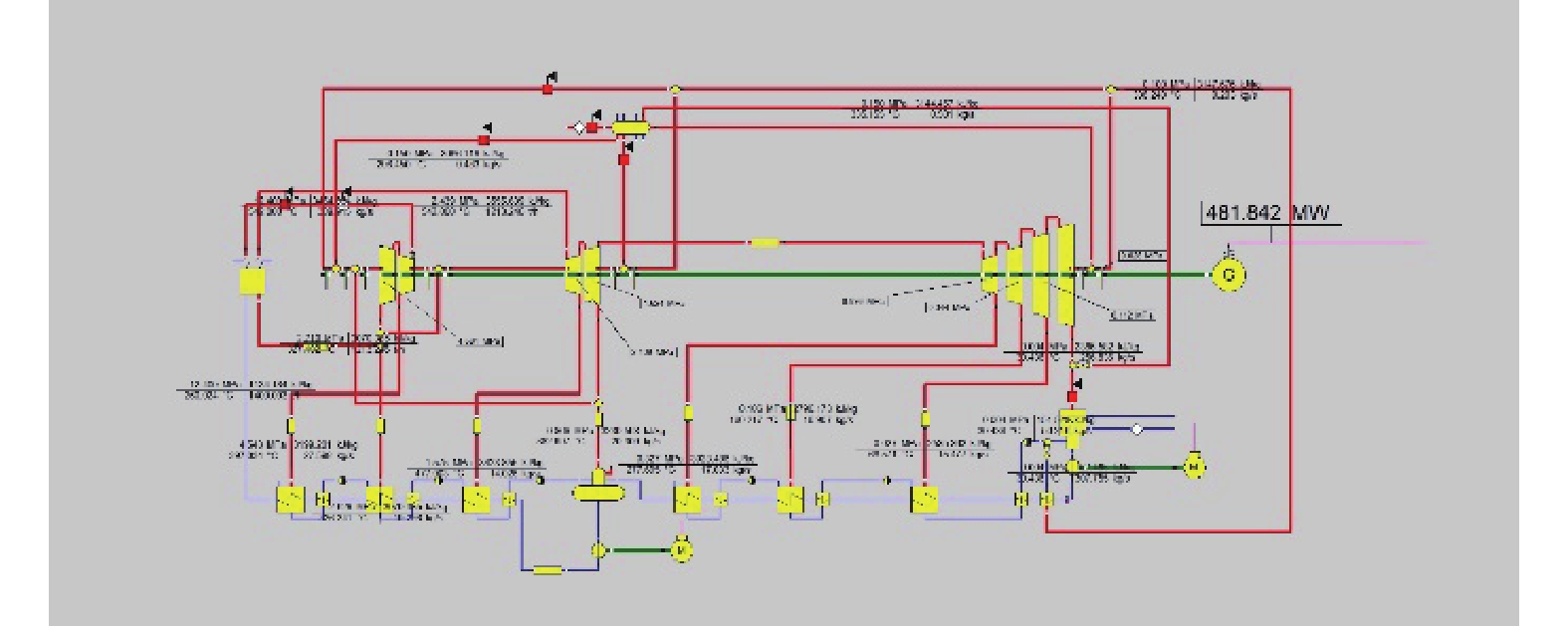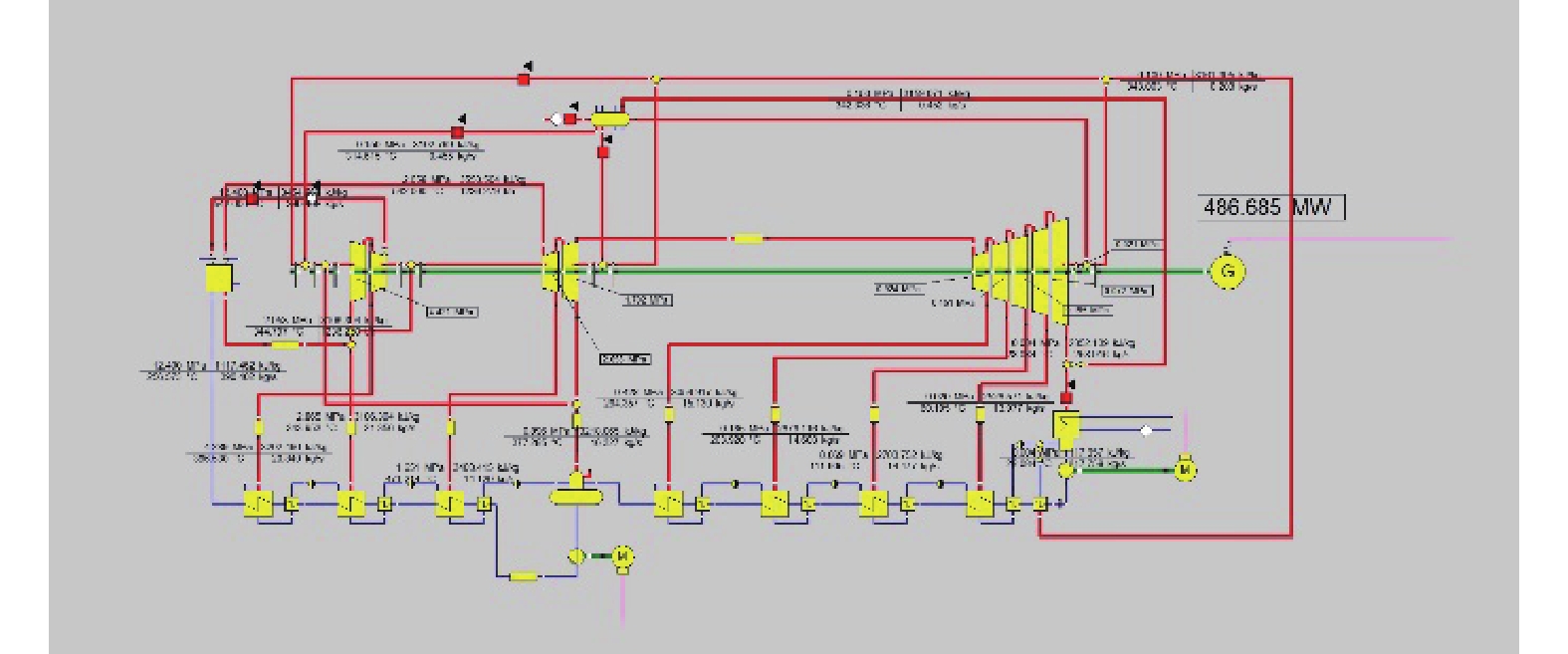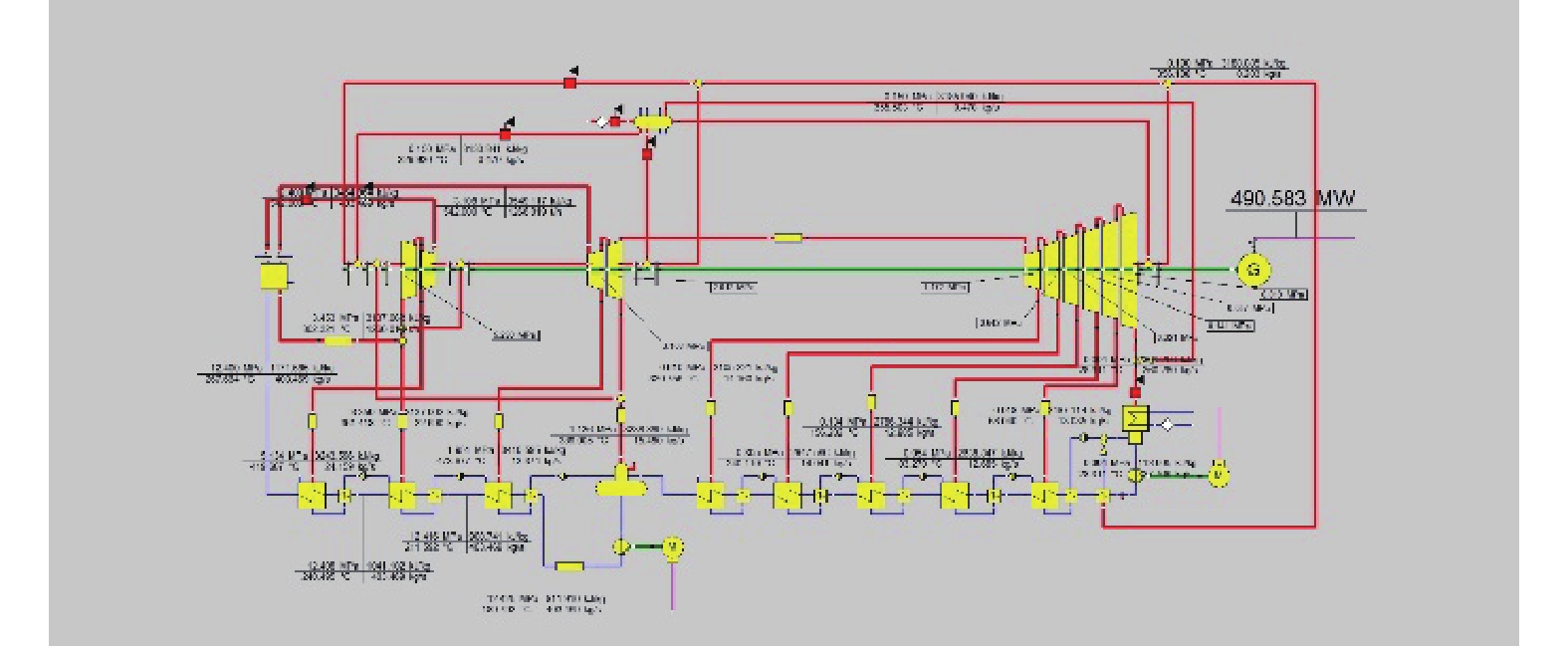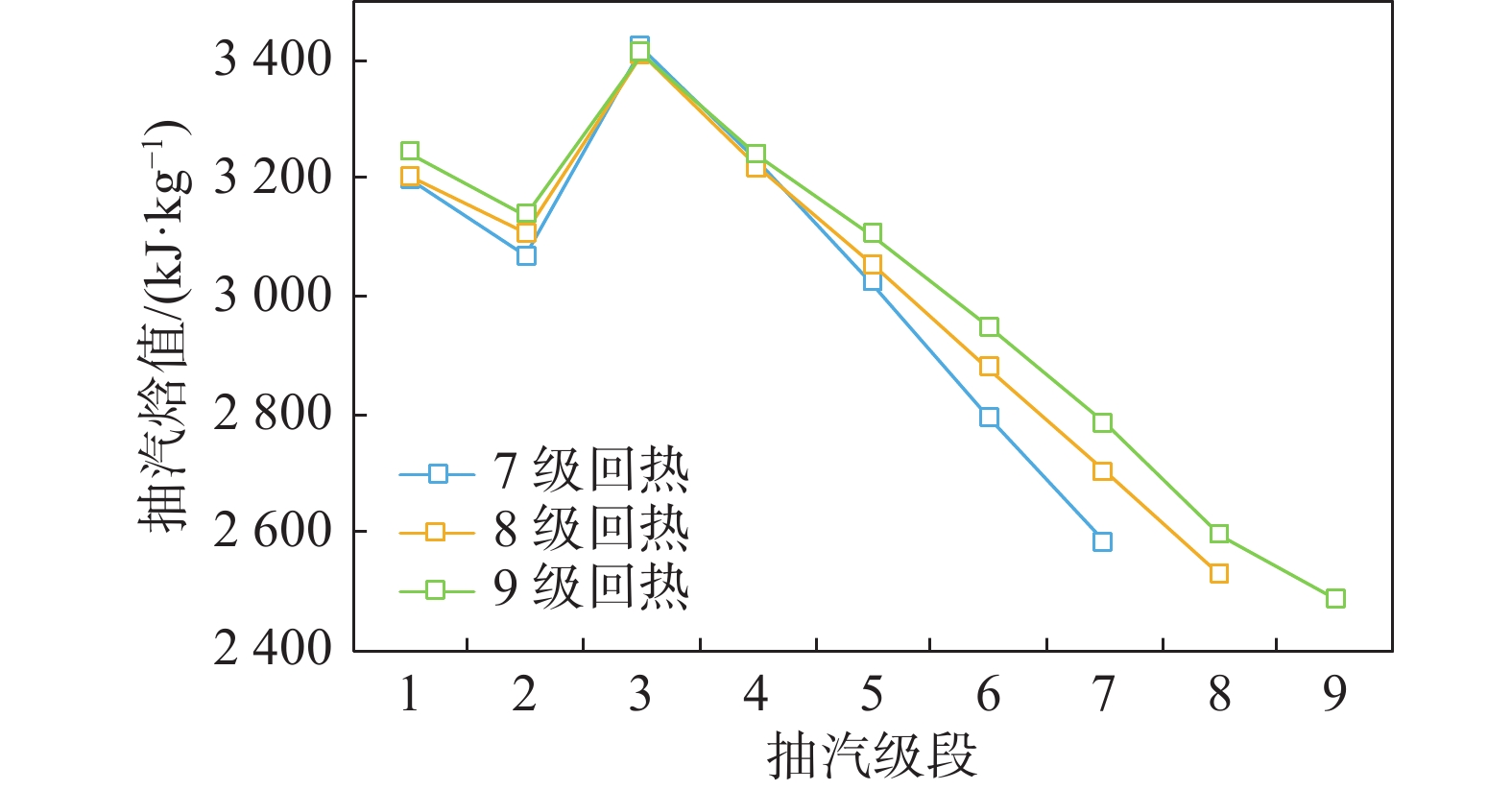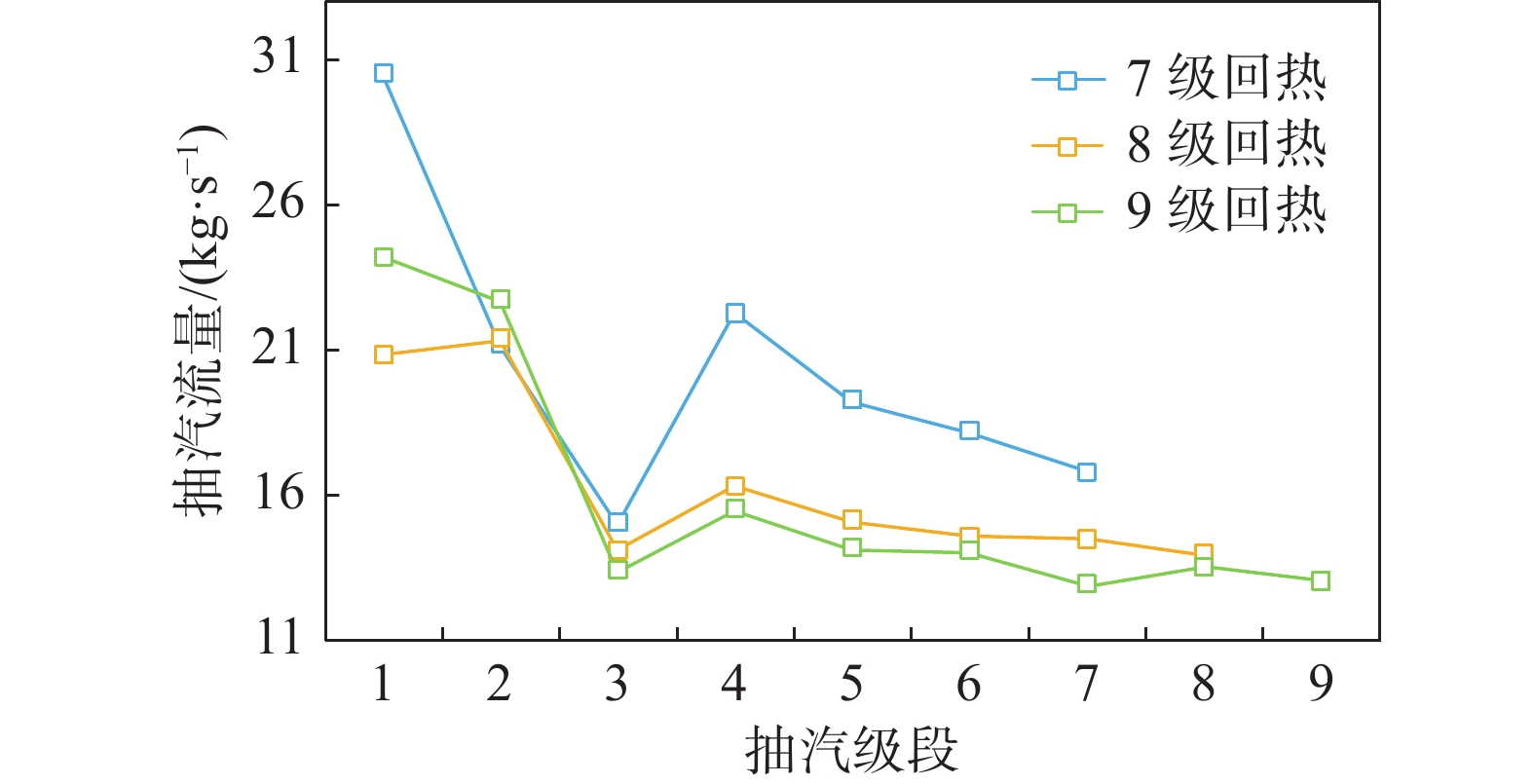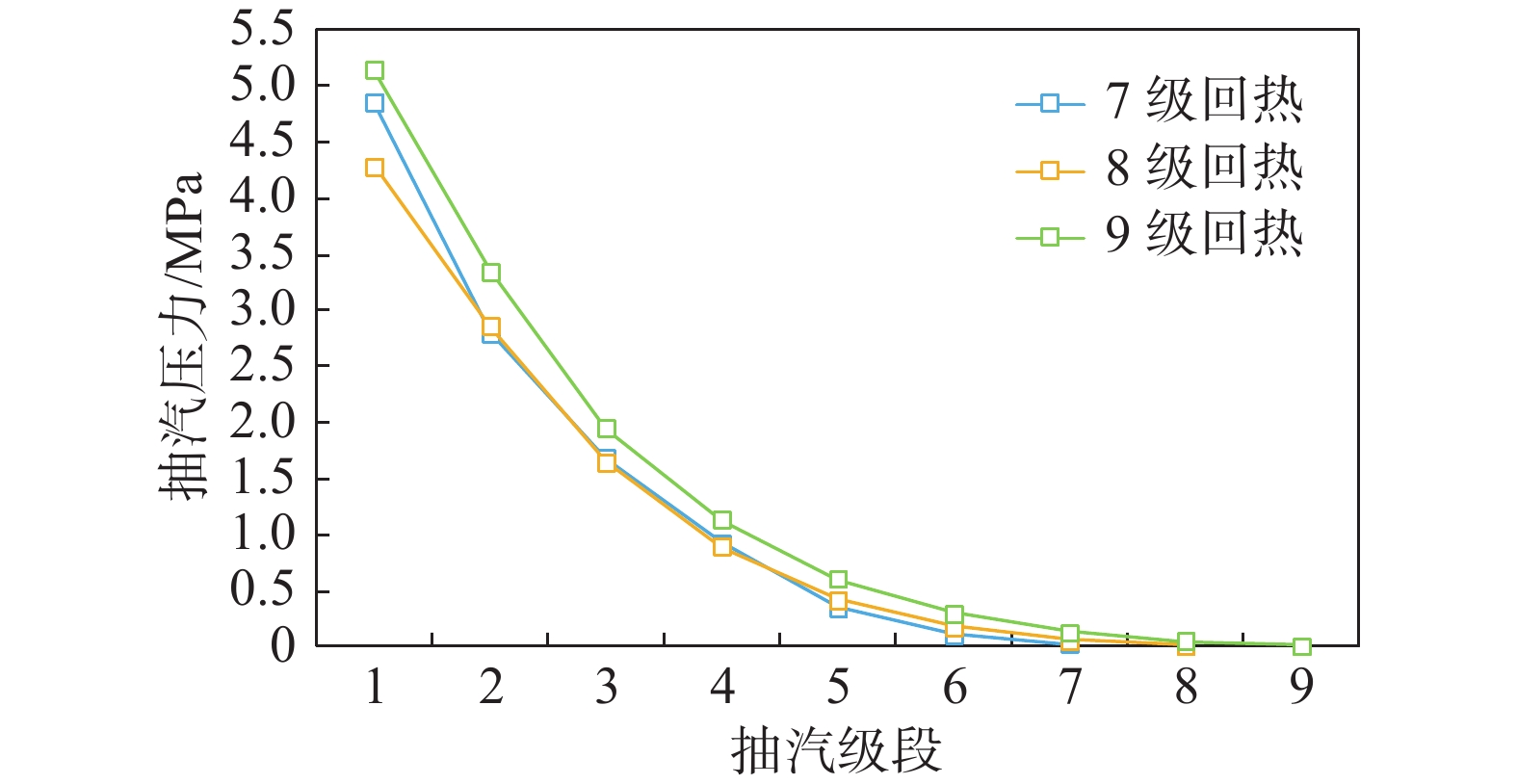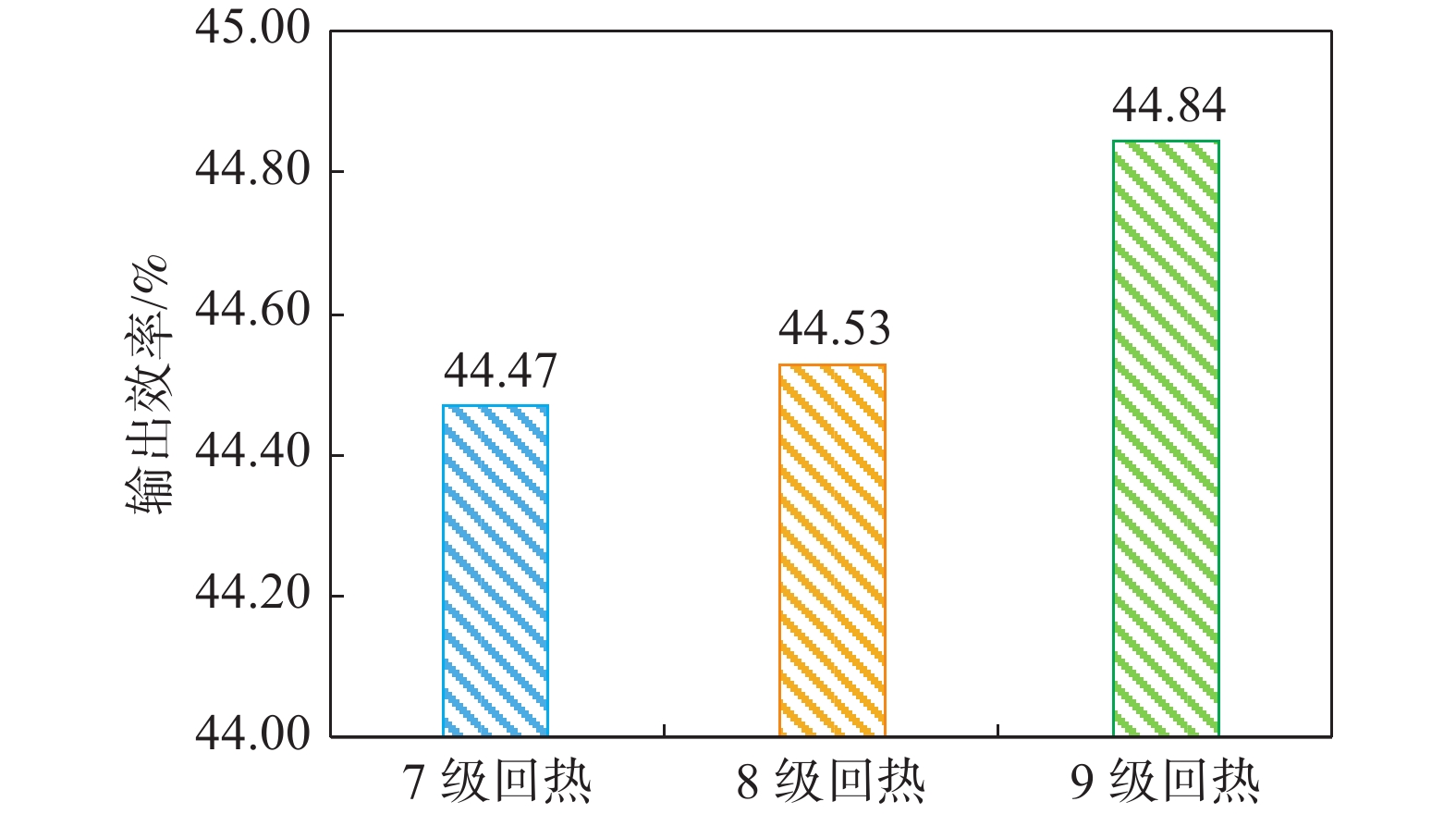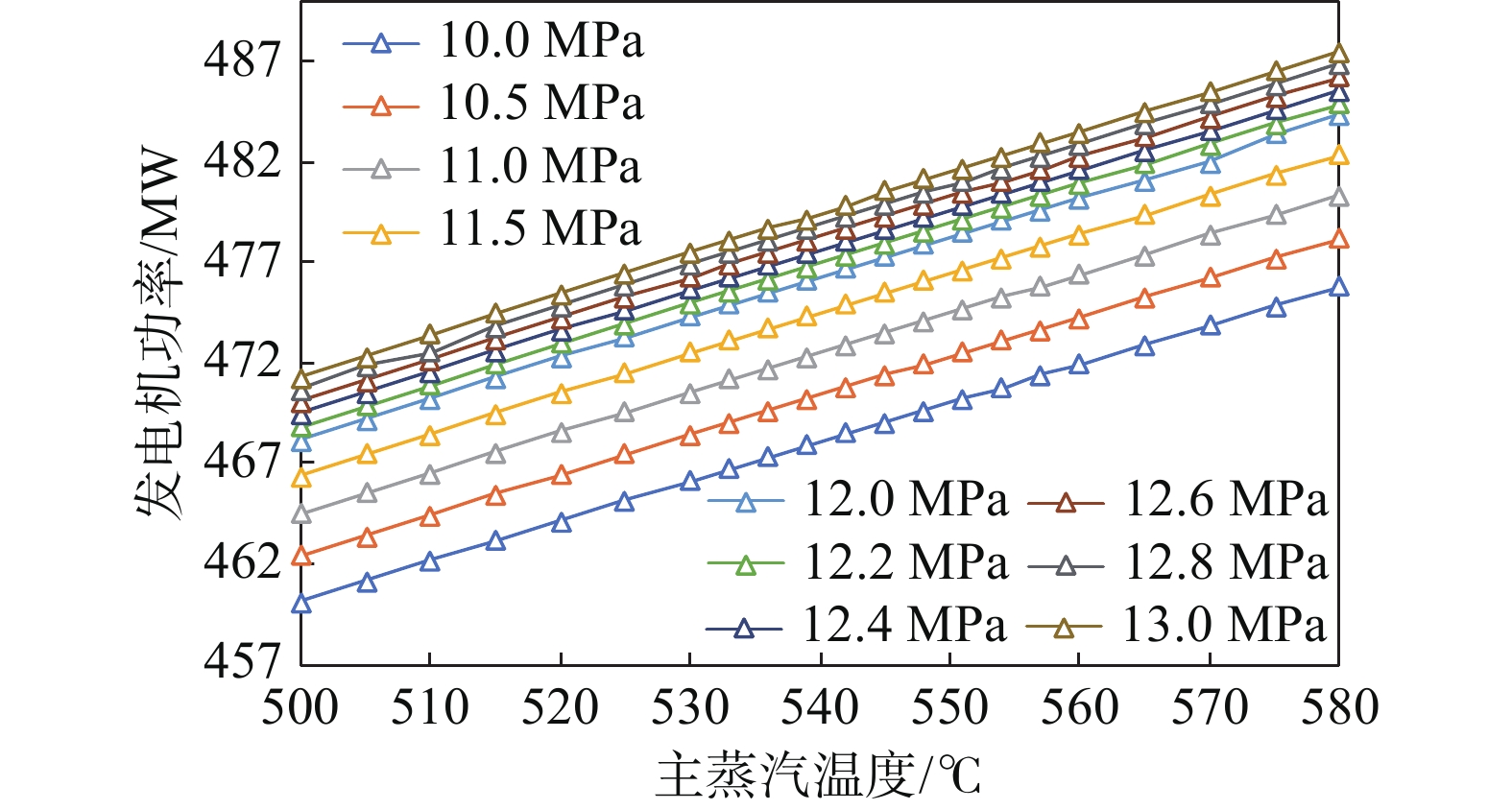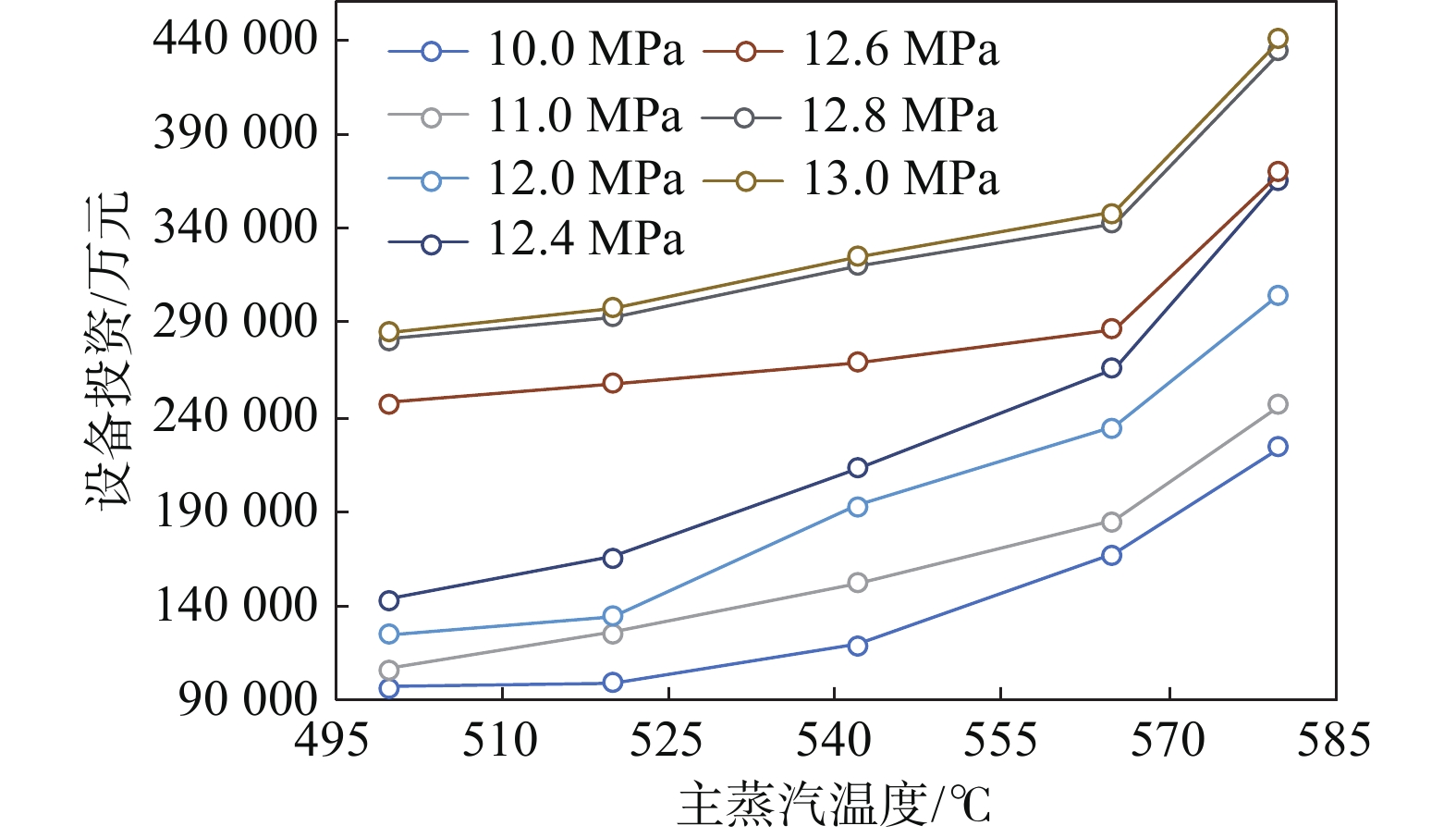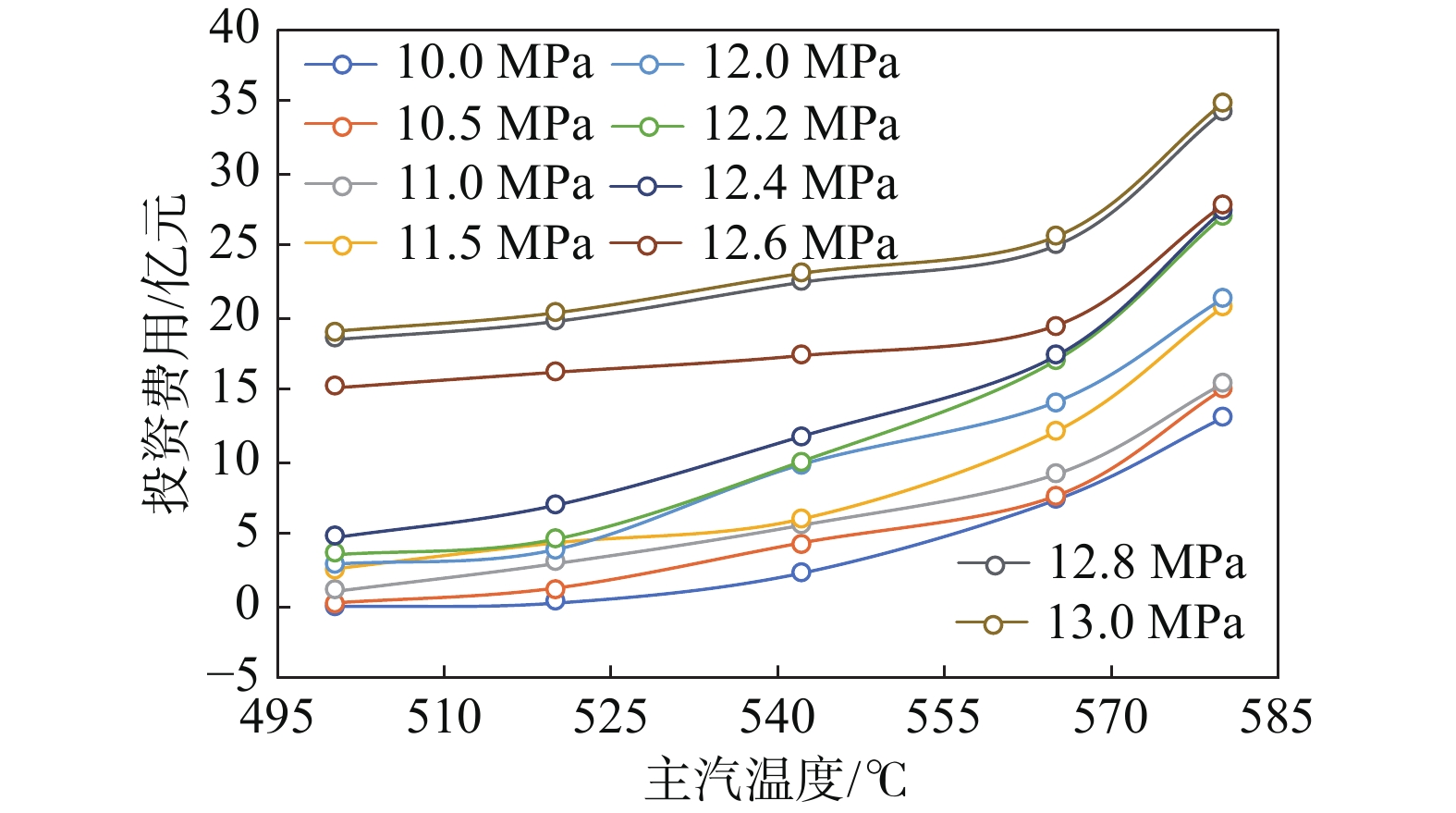-
如今全球正处于低碳、零碳能源转型浪潮之中,我国许下了力争在2030年前实现碳达峰、努力争取2060年前实现碳中和的庄严承诺,在能源领域的主要实施路径就是“一次能源零碳化,二次能源电力化”[1]。在已发现的一次零碳能源中,核能受资源禀赋限制最少、可靠性最强,特别是核聚变能原料在地球储量丰富,可谓是取之不尽、用之不竭的“长寿能源”。在此背景下,核聚变能发电将是未来最理想的发电形式。
目前核聚变托卡马克(Tokamak)装置由于线圈磁体伏秒数的限制,只能进行周期脉冲模式运行,虽然随着技术的进步,等离子体放电脉冲长度将延长至分钟量级且脉冲间隙时间大幅缩短,但仍需配置合适的储能系统以满足商业发电的需求[2]。
中国聚变工程实验堆(China Fusion Engineering Test Reactor,CFETR)项目,是中国自主设计和研制、以中国为主联合国际合作的重大科学工程。CFETR运行时的能量流程主拓扑架构如图1所示,该图表示了从托卡马克主机热源到发电并网的能量流程,采用氦气-熔盐储能-水(汽)三回路系统(以下简称“三回路”)。Tokamak产生的热量通过氦气带出,之后氦气热量传递给储热熔盐,熔盐再将水加热为蒸汽实现蒸汽动力循环。发电岛包含储能岛和常规岛两部分,其中储能岛主要由储能缓冲系统、蒸汽发生器及其他附属系统组成;常规岛由汽轮机蒸汽动力循环系统、同步发电机和并网变压器等组件组成。

Figure 1. Schematic diagram of overall scheme of nuclear fusion power plant[3]
三回路设有一台容量为400 MW级汽轮发电机组。三回路蒸汽参数及热力方案对发电岛投资和发电收益有重大影响。高参数固然提高循环效率,但增加了初投资;低参数循环效率不高,但成本低,未必经济性上没有优势。通过经济技术对比,确定综合经济性较优的三回路蒸汽参数以及热力方案,对于聚变堆的工程应用有重大意义。本研究依据储能岛提供的输入条件,研究三回路热力系统配置,综合考虑主汽参数、再热参数、给水参数、回热级数、回热参数等因素,从经济技术角度得出三回路热力方案,并给出推荐意见。
-
三回路热力系统的输入条件如下:(1)输入热功率:1 066 MW;(2)主蒸汽温度:500~580 ℃;(3)主蒸汽压力:10.0~13.0 MPa(a);(4)高温再热蒸汽温度:≤ 580 ℃;(5)给水温度:≥ 250 ℃;(6)凝汽器背压:5.0 kPa(a);(7)年利用小时数:7 000 h;(8)上网电价:0.43元/kWh。
另外,经汽轮机厂反馈,10.0~13.0 MPa(a),500~580 ℃参数均在厂家成熟机型范围内。
-
Ebsilon是一款电站通用可视化组态、热力学机理建模和热平衡计算仿真软件,是一个模拟仿真的平台。可以用来对不同类型的电站进行设计、检查和优化,计算质量平衡、热平衡,研究环境的变化对系统的影响以及新上设备在循环中的运行,还可以对电站进行动态的监测监控。
如图2所示,Ebsilon是由基本模块和多个拓展模块组成的。基本模块包括由火力汽轮机汽水循环模型、核电汽轮机汽水循环模型、溴化锂吸收式制冷机/热泵、ORC发电循环、卡琳娜发电循环、超临界CO2发电循环。基本模块的核心功能是建模和绘图界面、计算求解核心、设计模式和变工况模式、90%以上的组件可用以及100%的物性库。而拓展模块是软件可选的扩展包,其运行必须依赖于基本模块,包含有GT-Lib燃机库、RE-Lib内燃机库、EbsScript编程模块、EbsOptimize优化模块、Validate校验模块、EbsHtml网页模块、EbsSolar光热模块、EbsBoiler锅炉模块。每一个拓展模块包含了各自不同的功能,有的功能是拓展了一些算法,而有的则是拓展了若干组件。
Ebsilon元件库里有单个的设备模型,可根据电站系统的复杂程度或研究问题的精度需要建立热力系统。简单的热力循环系统包括锅炉、汽轮机、冷凝器、给水泵、发电机和监察元件。软件每次计算遵循以下原则:流动时质量守恒;热功转换时能量守恒;水或水蒸气变化状态时状态参数之间有其自身规律;设备中发生的过程有其自身的过程特点。
图3展示了Ebsilon模型搭建过程。在可视化的图形用户界面内,可以通过将模块组合成设备,再将设备组合成系统的方式来构建Ebsilon模型[4]。通常采用顺序搭建法依循设备的连接关系逐个搭建。首先,将单个模块组合成设备单元,设置输入数据及计算模式。然后,加入另一个运行成功的设备单元,让这两个设备单元连接,设定输入输出,校验设备模型搭建的准确性。重复上述步骤,依次完整闭环每一个设备单元并进行查漏补缺(添加小流量,轴封等)。标定各部件初始参数,使得运行成功。根据分析结果进一步修正模型。
-
多级回热分配可以采用汽轮机设计时普遍使用的平均分配法,即每一级给水加热器内给水的焓升相等,这种方法简单易行[5]。
每一级加热器的给水焓升为:
$$ \Delta {h}_{\mathrm{f}\mathrm{w},\mathrm{o}\mathrm{p}}=\dfrac{{h}_{\mathrm{z}}-{h}_{\mathrm{c}\mathrm{d}}}{Z+1} $$ (1) 式中:
$ {h}_{{\mathrm{z}}} $ ——蒸汽发生器运行压力对应的饱和水比焓(kJ/kg);
$ {h}_{{\mathrm{cd}}} $ ——冷凝器出口凝结水比焓(kJ/kg);
Z ——给水回热级数。
优化给水温度可提高回热循环汽轮机绝对内效率。采用平均分配法进行回热分配时,其最佳给水比焓为:
$$ {h}_{\mathrm{f}\mathrm{w},\mathrm{o}\mathrm{p}}={h}_{\mathrm{c}\mathrm{d}}+Z\Delta h $$ (2) 按照蒸汽发生器运行压力$ {p}_{\mathrm{s}\mathrm{g}} $和最佳给水比焓$ {h}_{\mathrm{f}\mathrm{w},\mathrm{o}\mathrm{p}} $查水和水蒸汽表,可以确定最佳给水温度$ {T}_{\mathrm{f}\mathrm{w},\mathrm{o}\mathrm{p}} $。实际给水温度$ {T}_{\mathrm{f}\mathrm{w}} $往往低于理论上的最佳给水温度$ {T}_{\mathrm{f}\mathrm{w},\mathrm{o}\mathrm{p}} $,通常可以取为:
$$ {T}_{\mathrm{f}\mathrm{w}}\approx \left(0.65\sim0.75\right){T}_{\mathrm{f}\mathrm{w},\mathrm{o}\mathrm{p}} $$ (3) 由压力和实际给水温度,再一次通过等焓升分配的方法确定每一级加热器内的焓升。实际每一级给水焓升为:
$$ \Delta {h}_{{\mathrm{fw}}}=\dfrac{{h}_{{\mathrm{fw}}}-{h}_{{\mathrm{cd}}}}{Z} $$ (4) 式中:
$ {h}_{\mathrm{f}\mathrm{w}} $——给水比焓(kJ/kg)。
不同的焓降分配方法结果基本相似,常用的是比较简便的等温(或焓)升分配法。有再热的情况,由于高压缸排汽过热度低,而下一级再热后的蒸汽过热度高,一般使高压缸排汽这一级的加热器的给水焓升为相邻下一级的给水焓升的1.3~1.6倍[6-8]。
-
一次再热机组的主汽压损取主蒸汽压力的3% ~5%,再热压损不大于高压缸排汽压力的10%,再热器冷段管道、再热器、再热器热段管道的压损范围分别为汽轮机高压缸排汽压力的1.5%~2.0%、5%和3.0%~3.5%。
各抽汽段的管道压损,高压和中压缸取管道压力的3%,低压缸抽汽压损取1.5%[9-10]。
高压、低压给水加热器均为表面式加热器,加热蒸汽分别来自主汽轮机高压缸、低压缸的抽汽。高压给水加热器按具有过热蒸汽冷却段设计,上端差取为≥−1.7 ℃,低压给水加热器上端差一般取2.8 ℃[11-13]。
-
蒸汽再热器使用高压缸抽汽和蒸汽发生器新蒸汽加热,再热温度的提高对再热的经济效果总是有利的[14-15],但同样受到高温金属材料的限制。一般取再热温度接近于新蒸汽温度。当再热温度等于蒸汽初温度时,最佳再热压力为蒸汽初压力的18%~ 28%。当再热前有回热抽汽的可取22%~28%,再热前无回热抽汽的可取18%~22%[16-19]。
-
在Ebsilon进行电厂模拟时,凝汽器通常被模拟为一个等温过程。凝汽器进口和出口的压力也可以设置为相等。
轴封在Ebsilon里用模块123(Shaft Sealing)仿真,将漏气量作为轴封的“特性参数”,而其结构特点“齿数”作为“特性参数”漏气量的“主导因素”,在使用此模块时,只要根据电厂轴封的结构特征输入,即可仿真轴封漏气量。
给水泵在Ebsilon里用模块8(Pump)仿真,扬程和绝热效率$ {\eta }_{\mathrm{s}} $是描述其特性的关键参数。
-
通过Ebsilon模拟计算,分别得出7、8、9级回热各参数工况的热力数据,代表性数据见附录。
以主蒸汽进口温度542 ℃、12.4 MPa不同工况作代表,对比了7、8、9级回热级数的工况计算结果,其中,抽汽焓值、抽汽压力、抽汽温度和抽汽流量随压力范围变化的趋势如图7~图10所示,变化趋势符合实际情况。
各回热级数的抽汽参数变化曲线虽然不重叠,但只是由于级数不同而引起,大致的变化趋势仍然一致。
如图11所示,随着回热级数的增加,回路的输出效率也随着增加,但增长率只有0.2%左右,数值并不是特别明显。
对于回热级数,国产小机组一般采用的回热级数为1~3级,大机组为7~9级。对于400 MW的机组,一般选取7~9级的回热级数循环内效率提高最多。而对于本研究的计算,每增加一级回热级数输出效率增长并不明显。
以9级回热为例,各参数下机组发电功率如图12所示,从图中可以看出在本研究所选择的主汽参数范围内,随着温度和压力提高,机组发电功率逐渐增大,这与理论分析结论是完全一致的。
-
成本分析应以整个发电岛为研究对象,综合考虑储能岛和常规岛的总成本与收益,才能得出较为客观准确的经济性对比方案。
在进行热力方案经济性对比分析时,仅以因为三回路参数不同导致的设备的价格变化值为研究对象。因此需要定义基准工况作为对比基础。
-
成本分析时,汽轮机系统按主汽温度500 ℃、再热蒸汽温度500 ℃、主汽压力10 MPa为经济性分析的基准工况。
-
三回路参数和热力方案对汽轮机、给水泵、高压加热器、低压加热器、主汽和高温再热管道的成本有显著影响。在热力方案经济性对比分析时,仅关注不同主汽温度、不同主汽压力下投资费用相对基准工况的变化数值。暂不考虑不同主汽温度和不同主汽压力下系统的年运行费用的变化。
本研究中上述设备的价格水平按表1考虑(一台机组)[20]。可以看出,当三回路参数在500~580 ℃,10.0~13.0 MPa(a)范围内变化时,常规岛初投资成本对参数不敏感。因此,本研究选用9级回热方案,这对整个发电岛的经济性是有利的,但是主汽和再热参数需要根据储能岛的设备成本综合考虑。
设备 总价/亿元 备注 汽轮机 2.000 在500~580 ℃范围内,
主汽温度变化对价格影响不大给水泵(扬程11 ~ 14 MPa) 0.450 在11~14 MPa范围内,
扬程变化对价格影响不大高压加热器(≥ 14 MPa) 0.139 3级共3台 高压加热器(< 14 MPa) 0.132 3级共3台 低压加热器(3台) 0.070 三回路参数对每台低压
加热器的价格影响不大低压加热器(4台) 0.093 三回路参数对每台低压
加热器的价格影响不大低压加热器(5台) 0.116 三回路参数对每台低压
加热器的价格影响不大主蒸汽和高温再热蒸汽管道(SA335 P91) 0.308 - 主蒸汽和高温再热蒸汽管道(12Cr1MoVG) 0.084 - Table 1. Price of main equipment of the three-circuit system
-
储能岛主要由氦气-熔盐换热系统、熔盐储热系统、熔盐蒸汽发生系统及其相关管线和阀门组成。熔盐储热系统主要设备有冷、热熔盐罐各1台,熔盐泵6台;氦气-熔盐储热系统主要设备有16台氦气-熔盐换热器;熔盐蒸汽发生系统主要设备为8台预热器、8台蒸发器、8台过热器、8台再热器、4台汽包。
储能岛投资成本对参数较为敏感,详见表2和图13。在相同的主汽压力下,主汽温度越高,储能岛投资越大,500~525 ℃的投资变化不显著,525~ 565 ℃投资逐渐加大,565~580 ℃投资显著增加。在相同主蒸汽温度下,主汽压力越高,储能岛投资越大,但当压力达到12.4 MPa时,投资显著增加。
主汽参数 总价估算/亿元 主汽参数 总价估算/亿元 10 MPa/500 ℃ 9.7257 10 MPa/520 ℃ 9.9385 10 MPa/542 ℃ 11.9678 10 MPa/565 ℃ 16.8095 10 MPa/580 ℃ 22.4683 11 MPa/500 ℃ 10.7367 11 MPa/520 ℃ 12.6494 11 MPa/542 ℃ 15.2578 11 MPa/565 ℃ 18.5188 11 MPa/580 ℃ 24.7170 12 MPa/500 ℃ 12.5180 12 MPa/520 ℃ 13.5057 12 MPa/542 ℃ 19.3624 12 MPa/565 ℃ 23.4857 12 MPa/580 ℃ 30.5741 12.4 MPa/500 ℃ 14.3608 12.4 MPa/520 ℃ 16.5947 12.4 MPa/542 ℃ 21.3126 12.4 MPa/565 ℃ 26.6121 12.4 MPa/580 ℃ 36.6224 12.6 MPa/500 ℃ 24.7590 12.6 MPa/520 ℃ 25.8262 12.6 MPa/542 ℃ 26.9492 12.6 MPa/565 ℃ 28.7397 12.6 MPa/580 ℃ 37.0138 12.8 MPa/500 ℃ 28.1328 12.8 MPa/520 ℃ 29.3781 12.8 MPa/542 ℃ 32.0473 12.8 MPa/565 ℃ 34.3055 12.8 MPa/580 ℃ 43.4866 13 MPa/500 ℃ 28.5890 13 MPa/520 ℃ 29.8608 13 MPa/542 ℃ 32.5796 13 MPa/565 ℃ 34.8650 13 MPa/580 ℃ 44.1029 - - Table 2. Investment estimation for energy storage system
-
将储能岛和常规岛初投资和发电收益,利用年总费用法进行经济性分析,结果如图14~图15所示。

Figure 14. The relationship between investment and parameters in energy storage island and three-circuit system

Figure 15. The relationship between annual total cost and parameters of energy storage islands and power generation island
从图14可知,储能岛加发电岛的相对总投资(以9级回热,10 MPa,500 ℃为基础)变化趋势与储能岛投资类似(见图13),主汽温度越高,投资越大,温度在500~525 ℃范围内,投资变化不显著,525~ 565 ℃投资逐渐加大,565~580 ℃投资显著增加。主汽压力越高,投资越大,但当压力达到12.4 MPa时,投资显著增加。
从图15可知,同一压力下,500~540 ℃区间,年总费用变化不大;各压力下年总费用最小值主要在520 ℃上下,540~560 ℃年总费用开始增加,经济性变差;560~580 ℃,年净费用变化加大,经济性显著变差。10~12.4 MPa之间,年总费用差异较小。
基于上述经济性分析,主蒸汽参数推荐范围为:10~12.4 MPa(a)、525~540 ℃。一般主蒸汽参数越高,汽轮发电机组的效率越高,机组的经济性越好;随着设备设计和制造水平的发展,储能设备的造价将逐年下降;因此,进行常规岛主蒸汽参数计算时,建议结合当前熔盐储热的经典蒸汽参数综合考虑,暂可按12.4 MPa、540 ℃进行分析设计,此时汽轮发电机组电功率为477.48 MW,发电效率为44.79%。
-
对于采用汽轮发电机组发电的电站,蒸汽参数和热力方案是工程设计开始之前要确定下来的技术规范。本研究依据储能岛提供的输入条件采用等效焓降法,利用Ebsilon对电厂进行了建模、计算得出了各热力方案的详细热力参数,并进行了对比。结合各热力方案储能岛和三回路初投资成本,三回路推荐采用9级回热,主蒸汽参数推荐范围为:10~ 12.4 MPa(a)、525~540 ℃。随着设备设计和制造水平的发展,储能设备的造价将逐年下降;因此,进行三回路参数选择时,建议结合当前熔盐储热的经典蒸汽参数综合考虑,暂可按12.4 MPa、540 ℃进行设计。
本研究对CFETR发电岛三回路参数及热力系统做定量分析,结论可以为后续CFETR聚变发电技术研究以及工程设计提供参考。
Research on Optimization of Three-Circuit Parameters for Thermonuclear Fusion Power Generation Island
doi: 10.16516/j.ceec.2023-351
- Received Date: 2023-12-24
- Accepted Date: 2024-03-11
- Rev Recd Date: 2024-03-07
-
Key words:
- fusion power plant /
- three-circuit system /
- molten salt energy storage /
- parameters selection /
- thermal scheme /
- thermal economy /
- equivalent enthalpy drop
Abstract:
| Citation: | LUO Xianyong, LI Bin, LIN Yan, et al. Research on optimization of three-circuit parameters for thermonuclear fusion power generation island [J]. Southern energy construction, 2024, 11(3): 1-11. DOI: 10.16516/j.ceec.2023-351 doi: 10.16516/j.ceec.2023-351 |


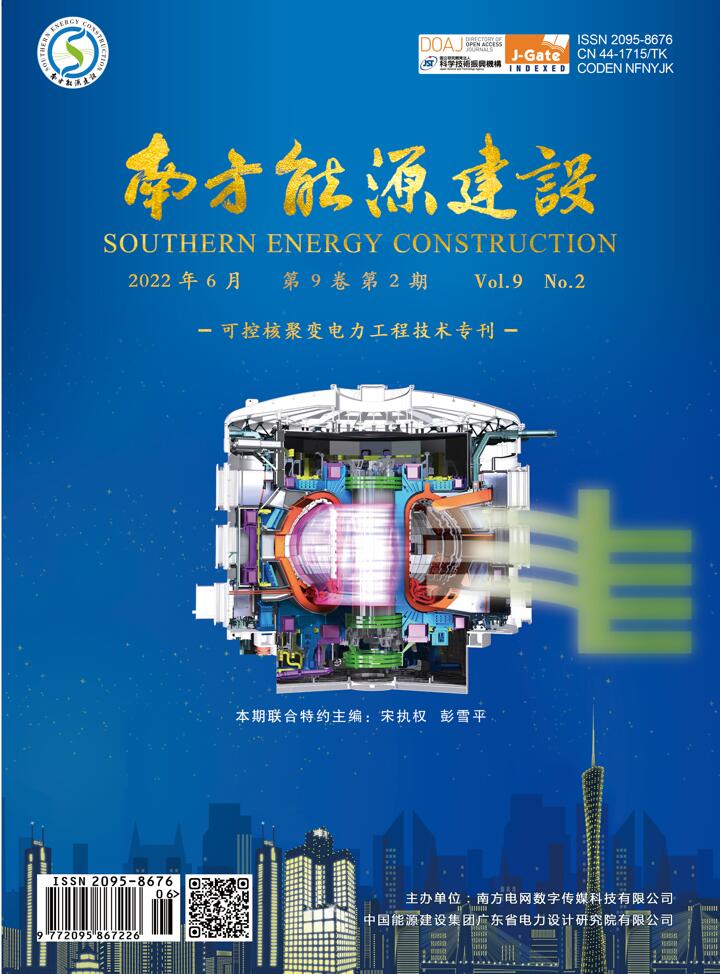
















 DownLoad:
DownLoad:


